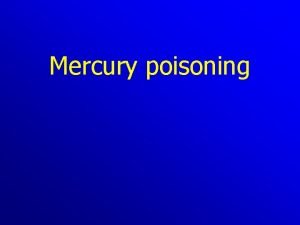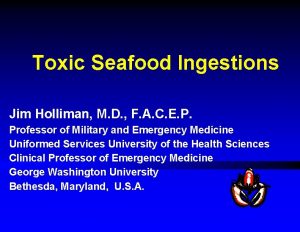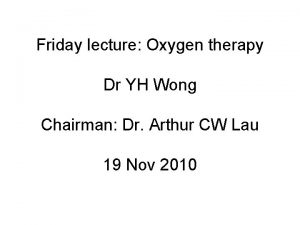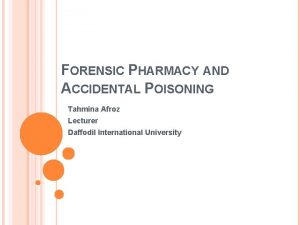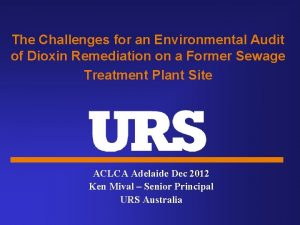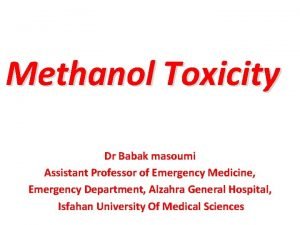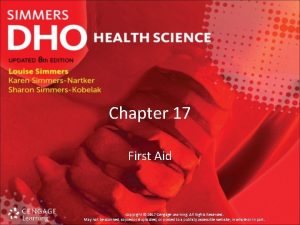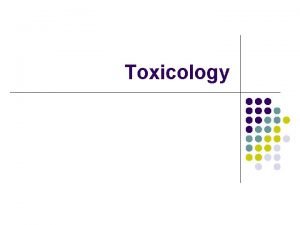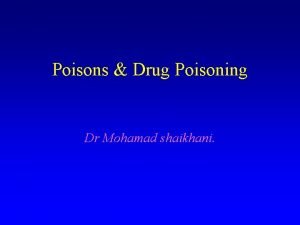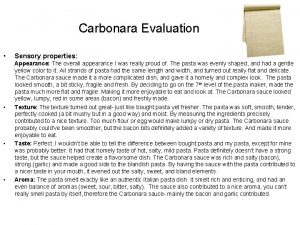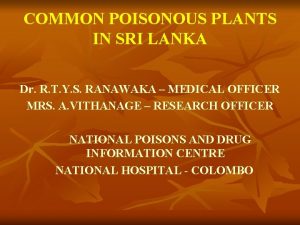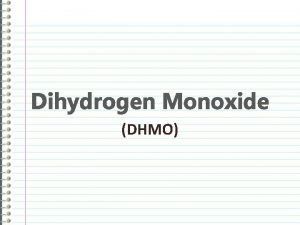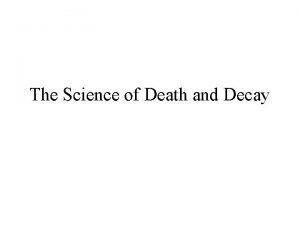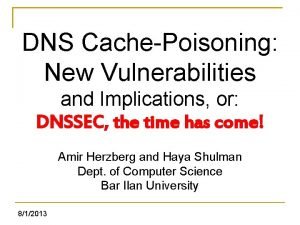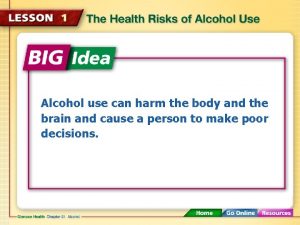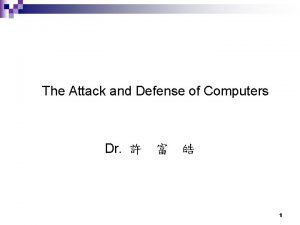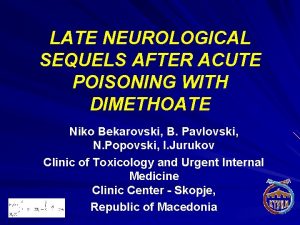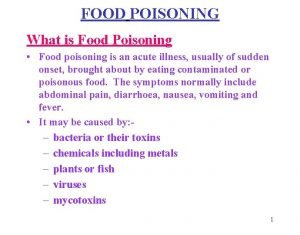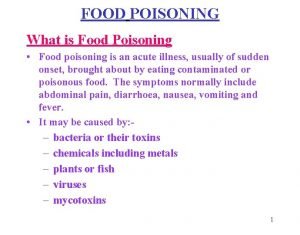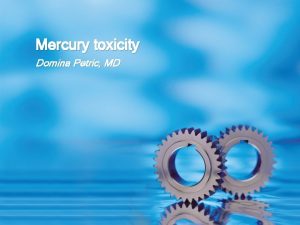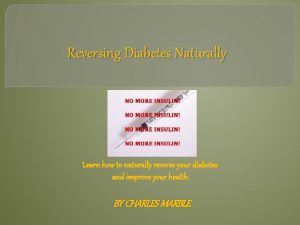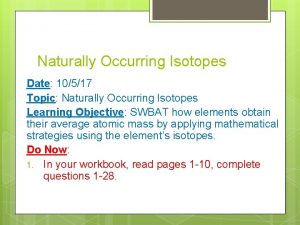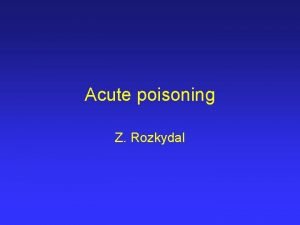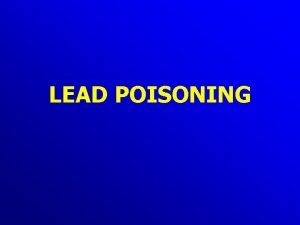Mercury Poisoning q Mercury q is a naturally























- Slides: 23

Mercury Poisoning q Mercury q is a naturally occurring metal, that is in many products everyday, although in tiny amounts q Small amounts of mercury are present in everyday foods and products, which may not affect our health. Mercury itself is naturally occurring, q but the amounts in the environment have been on the rise from industrialization q It is often a by-product of industrial processes, such as burning coal for power. v Mercury is a liquid at room temperature and v readily vaporizes into the air around it. v Vaporized mercury can make its way into the rain, soil, and water and v where it poses a risk to humans. plants, animals, like fish 25/1/2022 1

q Consuming foods with mercury is the most common cause of this type of poisoning. v The most common cause of mercury poisoning is from consuming too much methyl mercury or organic mercury, which is linked to eating seafood. v Children and unborn babies are the most vulnerable to the effects of mercury poisoning q Ingesting or coming into contact with too much mercury can cause poisonous q Mercury is a type of toxic metal that comes in different forms within the environment 25/1/2022

Mercury Poisoning Mercury and its compounds exist in three general forms: I. Elemental (or metallic). II. Inorganic: Mercury can combine with other elements (mainly chlorine, sulfur, and oxygen) to form Inorganic Mercury compounds. III. Organic: Mercury may combine with carbon or carbon-containing substances to make Organic Mercury compounds. q ü ü ü The difference lies in how it is absorbed, the clinical signs and symptoms, and Response to treatment modalities. v Elemental mercury is a heavy liquid. • • 13. 6 times the weight of water • Occurs naturally in soil and in the atmosphere from volcanic emissions ﺍﻻﻧﺒﻌﺎﺛﺎﺕ ﺍﻟﺒﺮﻛﺎﻧﻴﺔ • • Evaporates at room temperature • The vapor evaporates from the liquid and • evaporation occurs more rapidly when the liquid is heated. 25/1/2022 3

Mercury Poisoning v Organic compounds are further divided between • alkyl (carbon-chain) and • aryl (aromatic ring) groups. • Although all mercury compounds are toxic, • the small-chain alkyl compounds are the most hazardous q Mercury compounds vary in toxicity, so q OSHA provides standards for each. q It is important to clarify which category a compound belongs to • before comparing it with a standard or determining its relative toxicity. 25/1/2022 4

Uses and occupations at risk q. Mercury is used mainly for the electrolytic production of chlorine gas and caustic soda ﺍﻟﺼﻮﺩﺍ ﺍﻟﻜﺎﻭﻳﺔ , from brine (chlor-alkali industry). batteries , and electrical switches q. Also mercury compounds are used in: §pigments; §as a catalyst explosives §pharmaceuticals §chemical applications q. Mercury is commonly found in thermometers, manometers, barometers, gauges, valves, switches, batteries, and high-intensity discharge (HID) lamps. q Also used in amalgams for dentistry, q preservatives, heat transfer technology, and lubricating oils 25/1/2022

Uses and occupations at risk qmercury compounds used as a seed disinfectant, on food crops, As a biocide, q in paints and in paint formulations, qas a coating for mirrors, for the q manufacture of certain types of glass, qas a fungicide in paper (has been discontinued or banned). Permissible Exposure Limits The Occupational Safety and Health Administration (OSHA) standard for v Organo alkyl mercury compound is 0. 01 mg /cubic meter of air for TWA 8 v with a ceiling level of 0. 04 mg/cubic meter of air for TWA 8 (TWA 8). 8 -hour total weight average 25/1/2022 6

workers at risk of being exposed to mercury: Some examples of Ø Workers in facilities where electrical equipment is manufactured Ø Workers in fluorescent light bulb (CFL) recycling facilities Ø Workers in facilities where automotive parts are manufactured Ø Workers in chemical processing plants that use mercury Ø Workers in medical, dental, or other health services who work with equipment that contains mercury Ø Dentists and their assistants when breathing in mercury vapour released from amalgam fillings 25/1/2022 7

Mercury poisoning can result from I. vapour inhalation, II. ingestion, III. injection, or IV. absorption through the skin. q Following ingestion, • elemental mercury is poorly absorbed and • most of it is excreted in the feces. q absorbed through the skin § Elemental mercury liquid and vapor can be § absorbed through the skin in small amounts. q Elemental mercury is transferred to the developing child in a pregnant women q Inhalation route gives higher exposure 25/1/2022 8

q Inhalation route gives higher exposure q The vapor is well absorbed following inhalation. v it accumulates in the kidney and the brain. q Very toxic to the nervous system, also to kidneys q Elemental mercury is excreted from the body slowly. Ø It has an elimination half-life of 40 -60 days. ü Most elemental mercury is excreted in exhaled air, ü Small amounts in the feces and urine ü Very small amounts can be eliminated in sweat, saliva and milk. q Sources of non-occupational exposure to inorganic mercury include new dental fillings 25/1/2022 9

Health Effects: I. Short Term exposure II. long Term exposure 1. Short Term Exposure § Harmful effects are rarely seen any more because of strict controls used in workplaces where mercury exposure might occur. • Historically, q short-term exposure to high concentrations of mercury vapor caused harmful effects on the i. Nervous, ii. Digestive and iii. Respiratory systems, and iv. the kidneys. q In most cases, exposure occurred when mercury was heated 25/1/2022 10

Cont. . . Health Effects: II. long term exposure q It is caused by inhalation exposure. q Mercury liquid and vapor are absorbed through the skin in small amounts and this can contribute to the overall exposure. v Effects following absorption through the skin are expected to be similar to those reported for long-term inhalation exposure. q Mercury levels in urine are often used as a general indicator of how much exposure to mercury has occurred. v As a result, urine mercury levels rather than airborne levels are provided in some of the reports which compare mercury exposures to specific health effects. v Urine mercury levels are reported in microgram /gr of creatinine q The relationship between airborne mercury levels and urine mercury levels is complicated and depends on many factors, including other sources of mercury exposure & individual differences 25/1/2022 11

Urine mercury levels are reported in microgr/gr of creatinine Cont. …. q Several studies indicate that an airborne exposure of 0. 025 mg/m 3 mercury, compares to approximately 37 micrograms of mercury/gr of creatinine in urine. q Urine mercury levels in adults without occupational exposure are typically less than 3 micrograms/gram of creatinine. v Urinary mercury levels below 35 micgr/gram of creatinine ü are considered to reflect relatively low mercury exposure; v 35 to 50 micrograms/gram of creatinine reflects ü moderate exposure; v 50 to 100 micrograms/gram of creatinine reflects ü moderately high exposure v above 100 micrograms/gram of creatinine reflects ü high exposure. 25/1/2022 • 0. 01=14. 8 • 0. 04=59. 2 12

q Urine mercury levels are reported in micrograms/gram of creatinine (a component of the urine). Urinary mercury levels Level of mercury exposure less than 3 micrograms/gram of creatinine adults without occupational exposure below 35 micrograms/gram of creatinine low mercury exposure 35 to 50 micrograms/gram of creatinine moderate exposure; 50 to 100 micrograms/gram of creatinine moderately high exposure above 100 micrograms/gram of creatinine 25/1/2022 high exposure 13

Health Effects q Initial exposure to high concentrations of mercury vapor produces symptoms similar to "metal fume fever" including fatigue, fever, chills, nausea , headache, muscle joint pains and lack of appetite in v addition metallic taste in the mouth may also be reported, q Respiratory system effects include cough, shortness of breath, tightness and burning pains in the chest and inflammation of the lungs. q Occupational exposure to 1 -44 mg/m 3 of mercury vapor for 4 to 8 hours cause chest pain, coughing up blood, impaired lung function and inflammation of the lungs. v In some cases, pulmonary edema may occurred potentially life threatening q Exposure to high, but unspecified, concentrations of mercury vapor v will cause death due to respiratory failure. v All of the reported deaths resulted from inhaling mercury vapors formed upon heating mercury 25/1/2022 14

Health Effects 2. Harmful nervous system effects: ü Effects on muscle coordination, ü mood, behavior, ü memory, ü feeling , and nerve conduction • nervous, • digestive and • respiratory systems, • the kidneys v These effects are often observed in employees with moderately high or high exposure to mercury. ? ? ü Tremors (initially affecting the hands and sometimes spreading to other parts of the body), ü Emotional Instability (including irritability, excessive shyness, a loss of confidence and nervousness), ü Sleeplessness, Memory loss, Muscle weakness, Headaches, slow reflexes and a loss of feeling or numbness. 25/1/2022 15

Harmful nervous system effects Cont. … v Damage to the nerves of the arms and legs (poly-neuropathy) has been reported in employees with high exposures. ? ? ? ü Reduced sensation and strength in the arms and legs, muscle cramps and decreased nerve conduction have been observed. q Employees with episodes of very high exposure appear to be more At risk of developing these effects q Pathogenesis of Mercury Neurotoxicity v • Selectively accumulates in hippocampus, basal ganglia, cerebral cortex v • Prevents presynaptic serotonin release and inhibits serotonin transport; causes calcium disruptions v • Causes demylinating neuropathy v • Causes abnormal neuronal cytoarchitecture; disrupts neuronal migration, microtubules, and cell division 25/1/2022 16

Health Effects Cont. … q Kidney injury is common following exposure to Ø high concentrations of mercury. Effects range from ü increased protein in the urine to kidney failure. q Exposure to high concentrations of mercury has also ü caused increased blood pressure and heart rate. q Effect when come in contact with skin: § Elemental mercury is not known to directly irritate the skin. § However, an allergic skin reaction may develop following contact with mercury. § Elemental mercury liquid and vapor can be absorbed through the skin and may contribute to the overall absorption and toxicity q Pregnancy – the risky group first term pregnancies in the mercury exposed group • Spontaneous abortion Stillbirth • Congenital malformations (spina bifida and intra-atrial defect 25/1/2022 17

Diagnosing mercury poisoning Ø Physical exam and Ø blood and Ø urine test Few words on investigation v Blood mercury is only useful within 3 days of exposure and v it is more reliable in methylmercury (high concentrations in RBCs) v A 24 -hour urine specimen is a good indicator for inorganic mercury poisoning v • Hair mercury level has no role in acute Hg toxicity 25/1/2022 WHO, 2002 18

Mercury Poisoning Treatment § There’s no cure for mercury poisoning. • Neurological effects from mercury toxicity are often permanent § When detected early, mercury poisoning can be halted. q The best way is to stop exposure to the metal. v Eat a lot of mercury-containing seafood, stop immediately. v If toxicity is linked to workplace, § Remove from the area to prevent further effects of poisoning. v If mercury levels reach a certain point start chelation therapy. • Chelating agents are: drugs that remove the metal from organs and help body dispose of them. q In inhalational mercury • No role of inducing emesis • Oral steroid is a common practice but without substantial evidence Ø Most inhalational form are self limited v If mercury levels reach a certain point start chelation therapy. v Hemodialysis is used in severe cases of toxicity when renal function has declined 25/1/2022

Control hazardous conditions o Mercury is a VERY TOXIC liquid. It is also CORROSIVE to many metals. o It also forms amalgams with some metals, like gold jewelry. q Controlling mercury exposure is best accomplished through: v substituting with a non-toxic chemical, depending on the application. If not: v engineering, v administrative, v personal protective equipment (PPE) q Engineering methods include: v Mechanical ventilation (dilution and local exhaust), v Process or personnel enclosure, control of process conditions, and process modification v Stringent ﺻﺎﺭﻡ control measures (closed handling system) or v isolation may be necessary. v Use a corrosion-resistant local exhaust ventilation system v separate from other exhaust ventilation systems v Cleaning of contaminated exhaust air before release to the 25/1/2022 20

Control hazardous conditions Cont. . . q Personal protective measures include: q Have appropriate PPE v Approved respiratory protection. If respiratory protection is required, q institute a complete respiratory protection program including v selection, fit testing, training, maintenance and inspection. v A face shield may also be necessary to protect eye and face. v Chemical protective gloves, coveralls, boots, and/or other chemical protective clothing are required to protect skin. v A chemical protective full-body encapsulating suit and respiratory protection may be required in some operations v Remove contaminated clothing immediately and put in a closed container. v Discard or launder before re-wearing. v Inform laundry personnel of contaminant's hazards. q Do not eat, drink, or smoke in work areas. q Wash hands thoroughly after handling this material. q Maintain good housekeeping 25/1/2022 21

q Handling recommendations for the industrial use of mercury. v Before handling, it is important that: § Engineering Controls are operating and § PPE requirements and personal hygiene measures are being followed. § People working with this chemical should be properly trained regarding its hazards and its safe use. § Unprotected persons should avoid all contact with this chemical § including contaminated equipment v Use the type of container recommended by the manufacturer Ø Inspect containers for leaks before handling § Immediately report leaks, spills or ventilation failures. § Never return contaminated material to its original container Ø Secondary protective containers must be used when this material is being carried. 25/1/2022 22

Handling recommendations for the industrial use of mercury Cont. … • Label containers. Avoid damaging containers. • Keep containers tightly closed when not in use. v Assume that empty containers contain residues which are hazardous § Avoid generating vapors or mists. § Do not heat mercury in other than a closed system. v Good housekeeping is very important Ø Do not use on porous work surfaces (e. g. wood). ü Use work surfaces which can be easily decontaminated 25/1/2022 23
 Mercury poisoning symptoms
Mercury poisoning symptoms Edgar allan poe mercury poisoning
Edgar allan poe mercury poisoning Clupeotoxin
Clupeotoxin Oxygen therapy
Oxygen therapy Acetaaminophen
Acetaaminophen Dioxin poisoning
Dioxin poisoning Bgp poisoning
Bgp poisoning Poisoning that disables the na+/k+ pump would
Poisoning that disables the na+/k+ pump would University of washington
University of washington Methanol poisoning
Methanol poisoning 17:8 providing first aid for cold exposure
17:8 providing first aid for cold exposure Ld 50
Ld 50 Dose of atropine in op poisoning
Dose of atropine in op poisoning Emanuela carbonara
Emanuela carbonara Divi kaduru tree
Divi kaduru tree Dihydrogen monoxide poisoning
Dihydrogen monoxide poisoning Alcohol poisoning vs hangover
Alcohol poisoning vs hangover Carbon monoxide poisoning
Carbon monoxide poisoning Dns cache poisoning attack tutorial
Dns cache poisoning attack tutorial Alcohol poisoning
Alcohol poisoning Seo poisoning wikipedia
Seo poisoning wikipedia Neminath hubballi
Neminath hubballi Dimethoate poisoning
Dimethoate poisoning Dns cache poisoning example
Dns cache poisoning example
